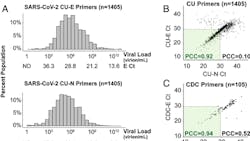2% of SARS-CoV-2−positive individuals carry 90% of virus in populations
The Proceedings of the National Academy of Sciences of the United States of American issued a research article, in which it analyzed data from saliva-based COVID-19 screening deployed on the University of Colorado Boulder campus. In the dataset, all SARS-CoV-2−positive individuals reported no symptoms at the time of saliva collection, and therefore were infected but asymptomatic or presymptomatic.
They continued:
The researchers found:
1) the distribution of viral loads observed in our asymptomatic college population was indistinguishable from what has been reported in hospitalized populations;
2) regardless of symptomatic status, approximately 50% of individuals who test positive for SARS-CoV-2 seem to be in noninfectious phases of the infection; and
3) just 2% of infected individuals carry 90% of the virions circulating within communities, serving as viral “supercarriers” and likely also superspreaders.
The researchers analyzed data from the fall 2020 pandemic response efforts at the University of Colorado Boulder, where more than 72,500 saliva samples were tested for severe acute respiratory syndrome coronavirus 2 (SARS-CoV-2) using qRT-PCR. All samples were collected from individuals who reported no symptoms associated with COVID-19 on the day of collection. From these, 1,405 positive cases were identified. The distribution of viral loads within these asymptomatic individuals was indistinguishable from what has been previously observed in symptomatic individuals.
Regardless of symptomatic status, ∼50% of individuals who test positive for SARS-CoV-2 seem to be in noninfectious phases of the disease, based on having low viral loads in a range from which live virus has rarely been isolated. We find that, at any given time, just 2% of individuals carry 90% of the virions circulating within communities, serving as viral “supercarriers” and possibly also superspreaders.
One key reason for this is that both presymptomatic and asymptomatic infected individuals can transmit the virus to others. Further, it is becoming clear that certain individuals play a key role in seeding superspreading events. Here, we analyzed data from a large university surveillance program. Viral loads were measured in saliva, which has proven to be an accessible and reliable biospecimen in which to identify carriers of this respiratory pathogen, and the most likely medium for SARS-CoV-2 transmission.
The researchers found that the distribution of SARS-CoV-2 viral loads on our campus is indistinguishable from what has previously been observed in symptomatic and hospitalized individuals. Strikingly, these datasets demonstrate dramatic differences in viral levels between individuals, with a very small minority of the infected individuals harboring the vast majority of the infectious virions.
Proceedings of the National Academy of Sciences of the United States of America has the release.
